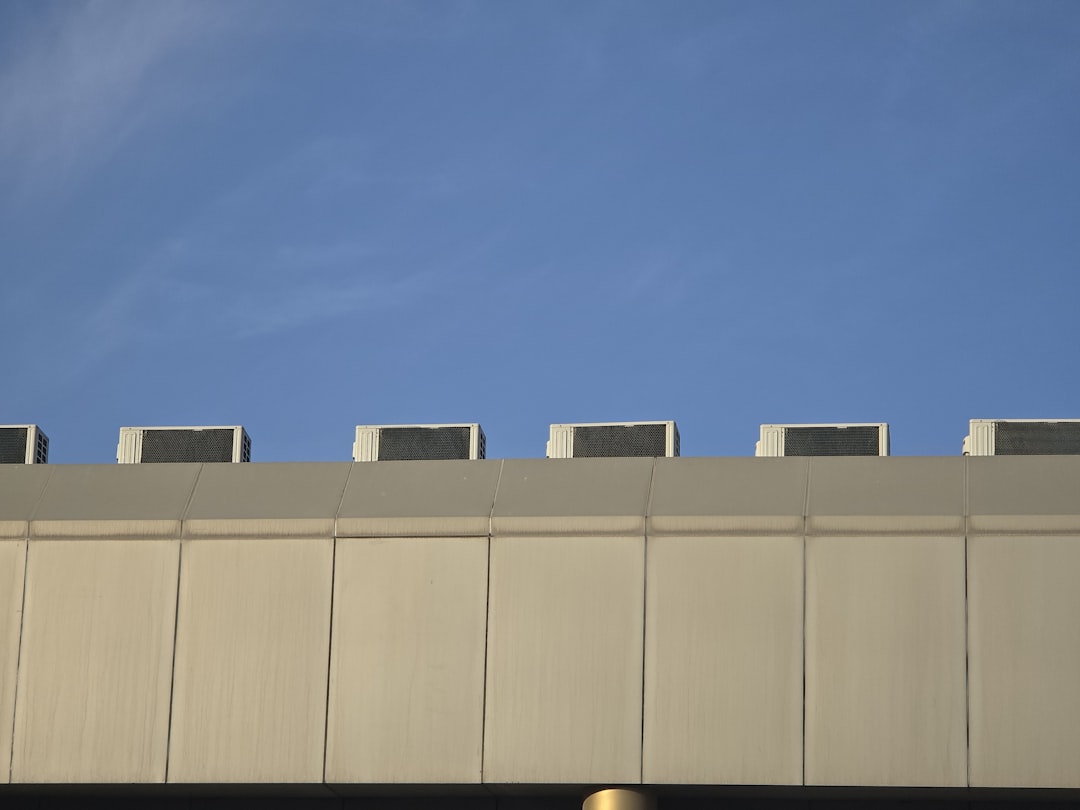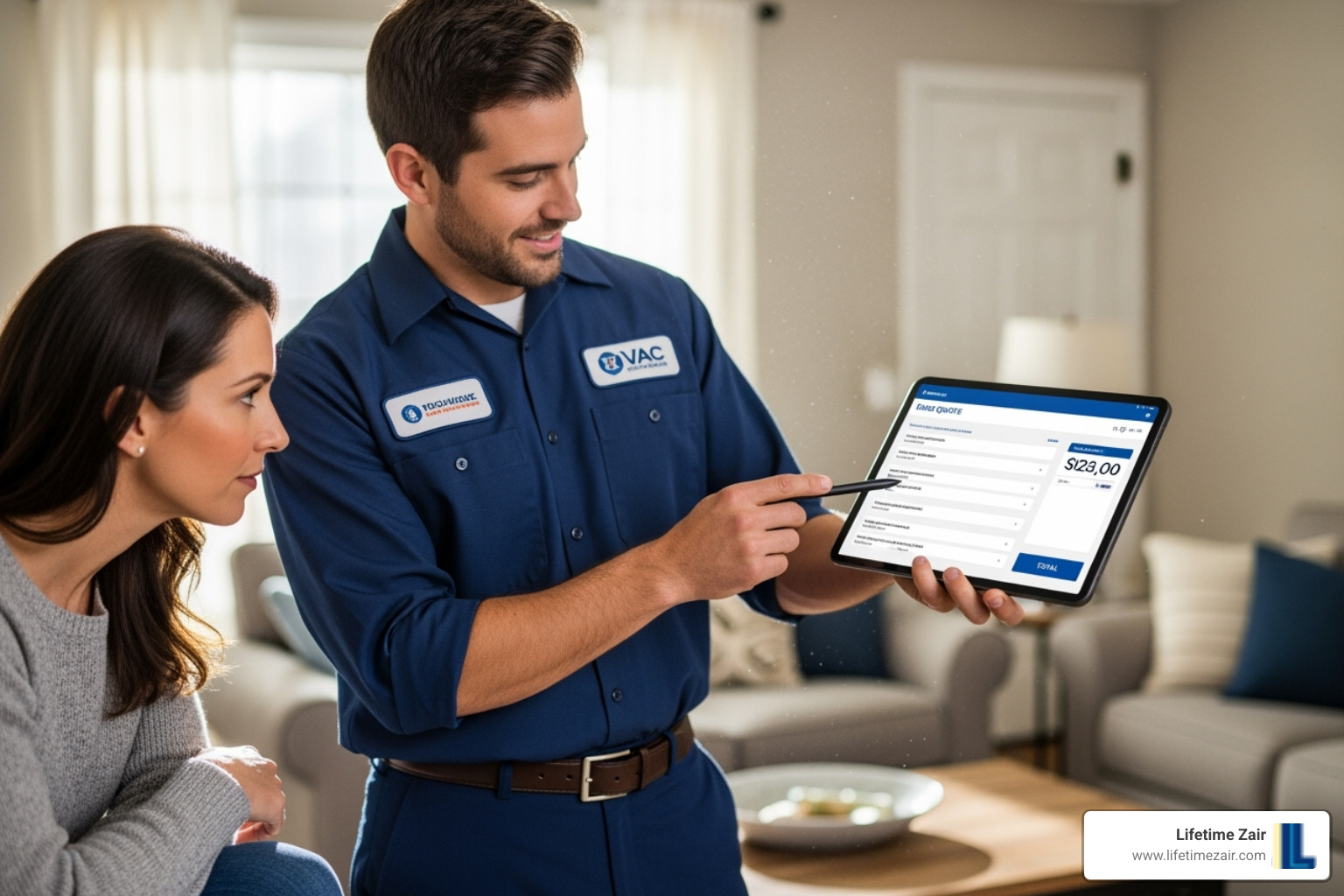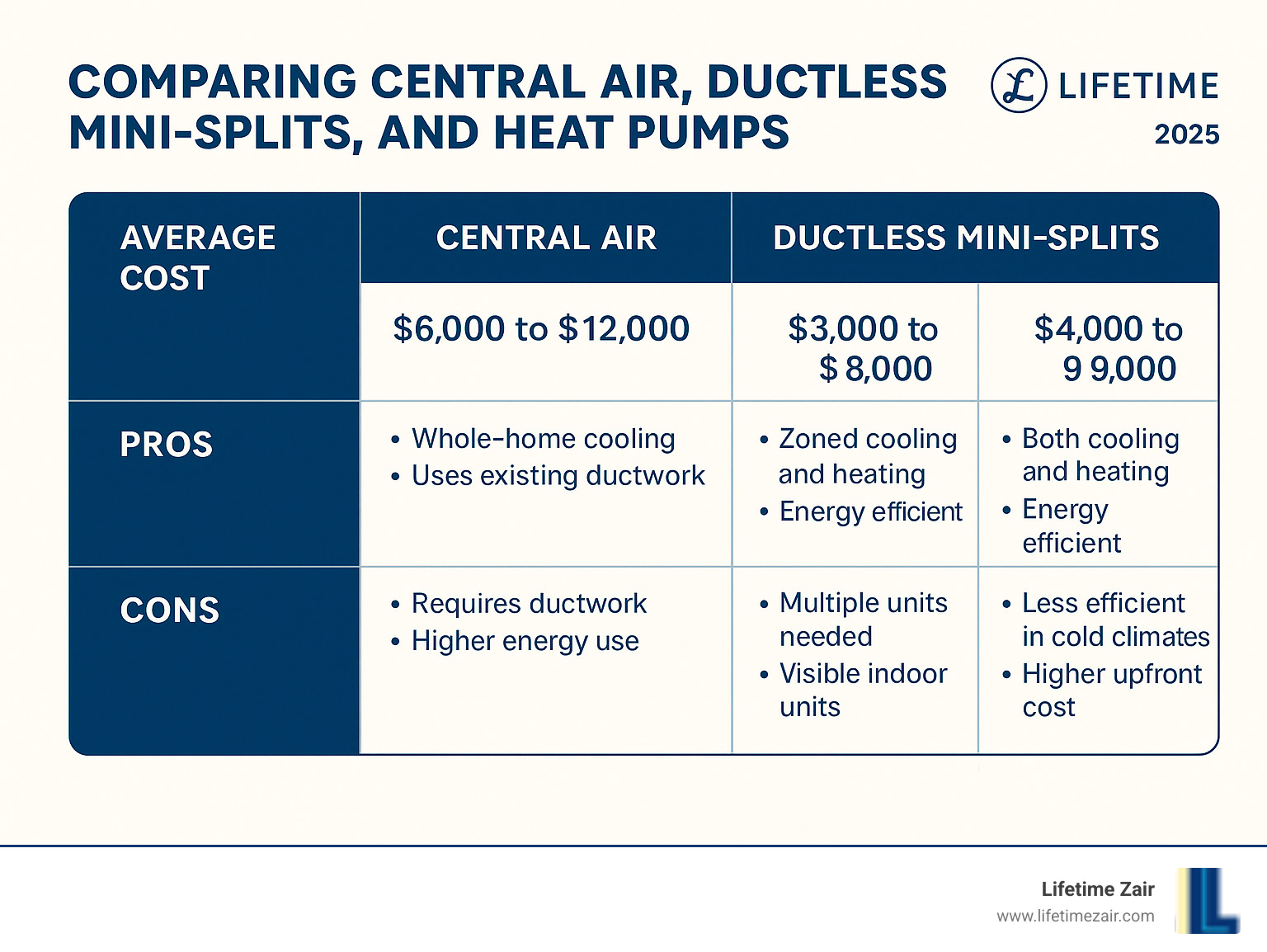Understanding the Investment in Whole-Home Comfort
When you’re wondering how much is it to install central air, you’re looking at several key cost components that work together to bring reliable cooling to your entire home. The research shows installation costs vary widely based on your specific situation.
Quick Answer: Central Air Installation Cost Ranges
- Basic installation: $6,000 – $8,500
- Average installation: $8,500 – $11,500
- Premium installation: $12,000 – $20,000+
- With new ductwork: Add $2,000 – $10,000
Central air conditioning has become the most popular cooling choice for American homes, and for good reason. Unlike window units or portable ACs that cool just one room, central air provides consistent temperatures throughout your entire home while also filtering and dehumidifying the air.
But here’s what many homeowners find: the unit itself is just part of the story. Your total investment depends on factors like your home’s size, existing ductwork condition, energy efficiency preferences, and local labor costs.
As one homeowner shared: “When our furnace went out unexpectedly, we were worried about the cost. Our HVAC company offered flexible financing options that made the purchase manageable. It only took a few minutes to apply, and we were approved almost instantly.”
The good news? Understanding these cost factors upfront helps you budget properly and avoid surprises during installation.
The Bottom Line: Average Central Air Installation Costs
Let’s get straight to the heart of what you’re really asking: how much is it to install central air in your home? While every installation is unique, understanding the typical cost ranges helps you plan and budget for this important investment in your family’s comfort.
Average Costs: How much is it to install central air?
The national average for central air installation sits comfortably in the middle range we mentioned earlier. Most homeowners find their projects fall within this sweet spot, though your actual costs might lean higher or lower depending on your specific situation.
Basic installations typically involve straightforward setups in homes with existing, well-maintained ductwork and standard electrical connections. These projects usually require minimal modifications and use reliable, mid-efficiency equipment.
High-end installations often include premium features like variable-speed systems, smart thermostats, or extensive ductwork modifications. Larger homes naturally require bigger, more powerful units, which pushes costs toward the upper range.
There’s a good reason central air conditioning systems are the most popular cooling option across the country. Unlike window units that cool just one room, central air provides consistent comfort throughout your entire home while improving indoor air quality. If you’re curious about all the benefits, our guide explains why central air conditioning is the best choice for your home.
Breaking Down the Bill: Unit vs. Labor
When you’re figuring out how much is it to install central air, it helps to understand where your money actually goes. Think of your investment as having two main pieces: the equipment itself and everything needed to install it properly.
The AC unit makes up roughly half to two-thirds of your total project cost. This includes your outdoor condenser unit, indoor evaporator coil, and all the manufacturer components that come with your system. Higher efficiency units with advanced features like variable-speed compressors cost more upfront but often save money on energy bills over time.
Labor and materials cover the skilled work your HVAC contractor performs. This includes preparing your home, running new refrigerant lines, connecting electrical components, testing the system, and ensuring everything works perfectly. You’re also paying for additional materials like mounting pads, electrical connections, refrigerant, and various fittings that complete the installation.
Don’t forget about permits – most areas require them for central air installations. These fees ensure your installation meets local building codes and safety standards. While permits add to your upfront costs, they protect your investment and ensure the work is done right.
The good news? Understanding these cost components helps you have informed conversations with contractors and make the best decision for your home and budget.
Key Factors That Influence How Much It Is to Install Central Air
When homeowners ask us “how much is it to install central air?” we always explain that every home tells its own story. Your specific costs depend on several key factors that our experienced technicians carefully evaluate during their assessment.
Think of it like buying a car – the sticker price is just the starting point. The final cost depends on the size you need, the features you want, and what’s already in your garage (or in this case, your home’s existing infrastructure).
AC Unit Size (Tonnage & BTUs)
Here’s something that surprises many homeowners: air conditioner “size” has nothing to do with how much space the unit takes up in your yard. Instead, it’s all about cooling power, measured in BTUs (British Thermal Units) or tons.
One BTU represents the energy needed to cool one pound of water by one degree. In air conditioning terms, 12,000 BTUs equals one ton of cooling capacity. Your 1,200 square foot ranch might need a 2-ton unit, while your neighbor’s sprawling 3,000 square foot home could require a 4-ton system.
Getting the size right is absolutely critical. An undersized unit will run constantly, struggling to keep up on hot days and wearing itself out in the process. An oversized unit creates its own problems – it’ll cool your home too quickly without removing humidity, leaving you feeling clammy and uncomfortable.
That’s why we always recommend a Professional load calculation (called a Manual J). This detailed assessment considers your home’s square footage, insulation quality, window types, and even how many people typically live there. It’s the difference between guessing and knowing exactly what your home needs. Our guide on How To Tell If Your Air Conditioner Is Correctly Sized explains this process in more detail.
Energy Efficiency (SEER Rating)
Energy efficiency might seem like a “nice to have” feature, but it directly impacts both your upfront costs and your monthly electric bills. The SEER rating (Seasonal Energy Efficiency Ratio) works like a car’s MPG rating – higher numbers mean better efficiency.
The industry recently updated to SEER2 ratings, which reflect more realistic operating conditions. Different regions have minimum SEER requirements, with stricter standards in hotter climates where air conditioners work harder.
Here’s the trade-off: higher efficiency units cost more upfront but save money long-term through lower energy bills. A high-efficiency system might add to your initial investment, but many homeowners find the monthly savings make it worthwhile over the system’s 10-15 year lifespan.
Our Guide To Choosing An Energy Efficiency Air Conditioner can help you find the sweet spot between upfront costs and long-term savings for your specific situation.
Ductwork: The Hidden Cost Driver
If you already have ductwork in your home, you’re ahead of the game! But here’s what many homeowners don’t realize: existing ductwork condition can make or break your installation budget.
Our technicians thoroughly inspect your current ducts for air leaks, proper sizing, and overall condition. Even the most efficient new AC unit can’t perform well if it’s connected to leaky, undersized, or damaged ductwork. You might be surprised by some Signs Your AC Ductwork Needs Repair that aren’t immediately obvious.
Sometimes we can work with your existing ducts with minor modifications or sealing. Other times, new ductwork installation becomes necessary – and this is where costs can add up significantly. Installing new ducts is labor-intensive work that often involves accessing walls, attics, and crawl spaces.
The good news? Addressing ductwork issues upfront ensures your new system operates at peak efficiency, which means better comfort and lower energy bills.
Homes Without Ductwork: How much is it to install central air in this scenario?
Ah, the classic question from owners of charming older homes: “How much is it to install central air when I don’t have any ducts at all?”
Retrofitting challenges are real. Installing ductwork from scratch in an existing home is complex and can be quite invasive. We’re talking about carefully routing ducts through walls, floors, and ceilings while preserving your home’s character and minimizing disruption to your daily life.
This scenario typically means a higher installation cost because of the extensive labor involved. However, don’t let that discourage you! You have excellent alternative solutions that might actually work better for your home.
Ductless mini-split systems offer targeted cooling without any ductwork. High-velocity systems use smaller, more flexible ducts that are easier to install in tight spaces. Each option has its advantages depending on your home’s layout and your family’s needs.
We specialize in Ductwork Services Carrollton TX and surrounding areas, and we love helping homeowners explore all their cooling options. Sometimes the “impossible” home turns out to have the perfect solution waiting to be finded.
Comparing Cooling Systems: Central AC vs. Alternatives
When you’re wondering how much is it to install central air, you might also be curious about how it compares to other cooling options. The truth is, different homes have different needs, and what works perfectly for your neighbor might not be the best fit for you.
Let’s walk through your main options so you can make the smartest choice for your home and budget.
Central Air Conditioners
Central air is like the reliable friend who shows up consistently – it delivers steady, even cooling to every corner of your home. Most systems use what we call a “split system” design. Picture this: the noisy compressor and condenser live outside (where they won’t disturb your evening Netflix sessions), while the quiet evaporator coil works indoors, usually teaming up with your furnace.
Some homes use “packaged units” instead, where everything gets bundled into one outdoor cabinet. This setup works great when indoor space is tight or when the layout just makes more sense.
The big win with central air? It treats your whole home as one comfortable zone. No more hot bedrooms or chilly living rooms – just consistent temperatures everywhere. Plus, it’s constantly filtering and dehumidifying your air, which means better air quality for your family.
If you want that “set it and forget it” comfort throughout your entire home, central air usually takes the crown. We’re proud to offer comprehensive Central HVAC Services Carrollton TX and throughout our service area.
Ductless Mini-Split Systems
Think of mini-splits as the flexible, independent cousin of central air. Instead of one big system pushing air through ducts, you get individual indoor units mounted on walls or ceilings, all connected to one outdoor unit.
Here’s where mini-splits really shine: each indoor unit controls its own temperature. Want the bedroom cool while keeping the living room warmer? No problem. Only using the main floor today? Just cool that area and save energy on the rest.
This flexibility makes mini-splits perfect for homes without existing ductwork, room additions, or anywhere you want zoned cooling control. While adding multiple indoor units can increase costs, it’s often still more affordable than installing brand-new ductwork throughout your home.
The installation is usually less invasive too – just a small hole through the wall to connect the indoor and outdoor units. Our Guide To Ductless Air Conditioning Systems covers everything you need to know about this versatile option.
Heat Pumps
Heat pumps are the multi-talented performers of the HVAC world – they both heat and cool your home using the same equipment. In summer, they work just like a central air conditioner, pulling heat out of your house. But here’s the clever part: in winter, they reverse the process and actually extract heat from the outside air (yes, even when it’s cold!) to warm your home.
Air-source heat pumps are the most common type you’ll see. They’re incredibly efficient and work great in moderate climates. Geothermal heat pumps take efficiency even further by exchanging heat with the stable temperatures underground, but they require a significant upfront investment for the ground loop installation.
While heat pumps typically cost more initially than a standard AC unit, they’re essentially giving you two systems in one. In the right climate, the energy savings can be substantial over time, especially since you’re replacing both your air conditioner and your heating system.
We specialize in Heat Pump Installation in Lewisville TX and all our service locations, ready to help you explore whether this dual-purpose solution makes sense for your home.
The bottom line? Each system has its sweet spot. Central air excels at whole-home comfort, mini-splits offer flexibility and zoned control, and heat pumps provide year-round efficiency. The best choice depends on your home’s layout, existing infrastructure, and how you actually use your space.
Smart Ways to Save on Your New AC Installation
Nobody likes sticker shock, especially when you’re already dealing with a broken AC in the middle of summer! The good news is that there are several smart strategies to help manage the cost when you’re figuring out how much is it to install central air. With a little planning and research, you can significantly reduce your out-of-pocket expenses.
Take Advantage of Rebates and Tax Credits
Here’s where being an energy-conscious homeowner really pays off – literally! The government wants to encourage energy efficiency, and they’re willing to help you pay for it.
Federal tax credits can be a game-changer for your budget. When you install qualifying high-efficiency HVAC equipment, you might be eligible for substantial tax credits that directly reduce what you owe the IRS. These aren’t just deductions – they’re dollar-for-dollar credits that come right off your tax bill.
But don’t stop there! State and local programs often stack on top of federal incentives. Many states offer their own rebates for energy-efficient home improvements, and some local municipalities have additional programs to encourage residents to upgrade their cooling systems.
Your utility company might be your unexpected ally in this process. Many electric companies provide rebates for installing high-efficiency AC units because it helps reduce strain on the power grid during peak summer months. It’s a win-win situation – you save money, and they avoid brownouts.
Don’t forget about manufacturer promotions either. HVAC manufacturers frequently run seasonal promotions or rebates on their products, especially during slower sales periods.
The Energy Star rebate finder is an excellent resource to find what money-saving opportunities are available in your specific area. And hey, while you’re researching, check out our current Promotions page too – we often have special offers to make essential home comfort services more accessible.
Get Multiple Quotes and Time Your Purchase
Shopping around isn’t just smart – it’s essential. We always recommend getting quotes from at least three different HVAC companies, but here’s the key: don’t just compare the bottom-line numbers.
When you’re evaluating quotes, ask for detailed breakdowns that include the specific equipment model numbers, itemized costs for the unit and labor, any additional materials needed, permit fees, and comprehensive warranty information from both the manufacturer and installer. This approach ensures you’re truly comparing apples to apples rather than getting fooled by a low-ball quote that doesn’t include everything you need.
Timing your installation can also lead to significant savings. HVAC companies typically have “off-seasons” in spring and fall when demand is lower. During these periods, you might find more competitive pricing, better availability for scheduling, and contractors who have more time to focus on your project rather than rushing to the next emergency repair.
Of course, vetting your contractor is crucial to getting quality work at a fair price. Our guide on 7 Tips For Hiring An HVAC Contractor will help you choose a reputable and experienced professional who won’t cut corners or surprise you with hidden costs.
Understanding Your Financing Options
Let’s be honest – a new central air system represents a significant investment for most families. That’s exactly why we offer financing options to make quality home comfort more accessible. But it’s worth understanding all your choices.
Home equity loans or HELOCs (Home Equity Lines of Credit) often provide the most attractive terms, offering competitive interest rates and longer repayment periods by leveraging your home’s equity. Since you’re improving your home’s value and comfort, this type of financing makes a lot of sense.
Personal loans from banks, credit unions, or online lenders give you a fixed repayment schedule, usually over a shorter term. They’re straightforward and don’t require your home as collateral, though interest rates might be slightly higher.
For smaller projects, a credit card with a 0% introductory APR can work well if you can pay it off during the promotional period. Just be careful about those high interest rates that kick in afterward!
At Lifetime Zair, we believe everyone deserves comfortable, reliable cooling without breaking the bank. That’s why we offer flexible HVAC Financing Carrollton TX options throughout the Dallas-Fort Worth Metroplex. Whether you’re in Addison, Allen, Plano, Frisco, or any of our service areas, we’ll work with you to find a payment solution that fits your budget and gets your home comfortable again.
Frequently Asked Questions about Central Air Costs
We get it – when you’re thinking about how much is it to install central air, you probably have a bunch of questions swirling around in your head. You’re not alone! Here are the questions we hear most often from homeowners just like you, along with straightforward answers that actually help.
How long does a central air conditioning system typically last?
Here’s some good news: a well-maintained central air conditioning system typically lasts 10 to 15 years, and sometimes even longer with excellent care. Think of your AC system like a reliable friend – treat it well, and it’ll be there for you through many hot summers.
The secret to getting the most life out of your system? Regular maintenance is absolutely crucial. Just like your car runs better and longer with regular oil changes, your AC system thrives with annual tune-ups, clean filters, and prompt attention to small issues before they become big problems.
Don’t forget about warranties either! Most quality systems come with solid warranty coverage that gives you peace of mind during those early years. If you’re currently wrestling with an older system that’s giving you trouble, our guide on When To Replace Your HVAC Unit Instead Of Repairing It can help you figure out whether it’s time to repair or move on.
Is it cheaper to install central air or a mini-split system?
This is one of those “it depends” answers, but we’ll break it down so it makes sense. The condition of your existing ductwork is often the deciding factor when comparing costs.
If your home already has ductwork in decent shape, central air usually wins the cost battle for whole-home cooling. You’re essentially plugging into infrastructure that’s already there, which keeps installation simpler and more affordable.
But here’s where mini-splits shine: if your home doesn’t have ducts, or if installing new ductwork would be a major headache (think: concrete slab foundation or finished basement), a ductless mini-split system often comes out ahead financially. Plus, mini-splits give you the bonus of zoned cooling – you can keep the bedrooms cool while letting the unused guest room stay warmer, which saves energy and money.
Curious about which option might be more efficient for your specific situation? Check out our comparison guide: What Is More Efficient Centrals Air Or Ductless AC.
What is the average cost of a new high-efficiency air conditioner?
High-efficiency air conditioners definitely cost more upfront than standard models – there’s no getting around that. These units sport higher SEER ratings, which means they use less electricity to keep your home just as cool. It’s like comparing a gas-guzzling truck to a hybrid car – you pay more initially, but those monthly savings add up.
Here’s what makes the investment worthwhile: the long-term energy savings can be substantial. Many homeowners find that the money they save on their electric bills over the system’s lifetime more than makes up for the higher purchase price. Plus, you get the satisfaction of reducing your environmental footprint – it’s a win-win.
The key is looking at the total value over time, not just the sticker price. Our comprehensive guide, An Ultimate Guide To Air Conditioner Energy Efficiency, walks you through everything you need to know about making this smart investment for your home’s comfort and your wallet.
Get a Professional Estimate for Your Home
While this guide gives you a solid foundation for understanding how much is it to install central air, the truth is that every home tells its own story. Your home’s age, layout, existing systems, and your family’s comfort preferences all play a role in determining the best solution and its cost.
That’s where a professional assessment becomes invaluable. Rather than guessing at square footage calculations or trying to evaluate your ductwork from the basement, our experienced technicians can provide the accurate information you need to make an informed decision.
What happens during a professional estimate? We’ll walk through your home with you, taking precise measurements and examining your existing HVAC infrastructure. We’ll discuss your comfort goals – maybe you want whisper-quiet operation, or perhaps energy efficiency is your top priority. Some families need powerful cooling for their home office, while others want gentle, consistent temperatures throughout.
Our team at Lifetime Zair believes in transparent, honest assessments. We’ll explain what we find, discuss your options, and provide a detailed estimate that breaks down exactly what you’re investing in. No surprises, no pressure – just the information you need to move forward confidently.
The best part? We serve homeowners throughout the Dallas-Fort Worth Metroplex, including Addison, Allen, Argyle, Bartonville, Carrollton, Coppell, Corinth, Dallas, Denton, Flower Mound, Frisco, Grapevine, Grand Prairie, Garland, Hickory Creek, Irving, Lewisville, Little Elm, Lantana, McKinney, Pilot Point, Plano, Roanoke, Rowlett, Royse City, Southlake, Sachse, St Paul, The Colony, Trophy Club, and Wylie. Wherever you are in our service area, we’re ready to help you find the perfect cooling solution.
Ready to take the next step toward whole-home comfort? Request An Estimate for your AC installation in Dallas, TX and let’s start planning your family’s perfect cooling solution today!









